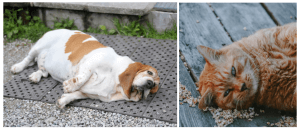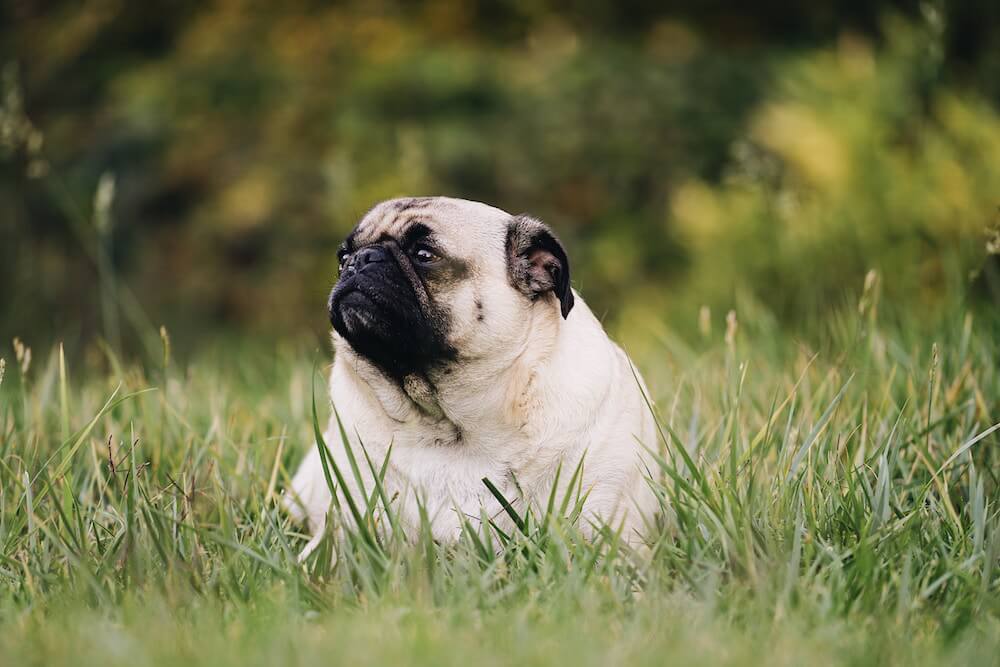Overweight and obesity a rising issue amongst Australian men and women, but our furry friends are getting fatter too! Australian data reveals 33.5% of dogs are overweight and 7.6% are obese, with a similar incidence in feline obesity*.
Anne Fawcett, veterinarian and lecturer in veterinary science at The University of Sydney, offers some insights on the reasons why our pets are becoming overweight. “We know that globally 22-44% of companion animals are overweight or obese. As a result of high-density living, we are seeing an increase in the number of animals housed indoors. This may result in reduced opportunities for dogs and cats to get incidental exercise.
“With the advent of high-nutrition diets, nutritional deficiencies are very rare. However, these highly concentrated diets, when fed alone, tend to reduce total feeding time. Animals may not feel full when fed smaller, concentrated rations.
“Additionally, owners may not measure food, which can lead them to unknowingly overfeed their pet.”
Unlike in humans, overweight and obesity does not lead to self esteem issues in cats and dogs but it can seriously impact their health in many other ways.
According to the authors of Canine and feline obesity: a One Health perspective, “a substantial body of veterinary literature documents that obesity in dogs and cats increases the risk of health problems.
“These problems include ‘orthopaedic disease, diabetes mellitus, abnormalities in circulating lipid profiles, cardiorespiratory disease, urinary disorders, reproductive disorders, neoplasia (mammary tumours and transitional cell carcinoma), dermatological diseases, and anaesthetic complications.”
Risk factors for overweight and obesity in cats and dogs
Disproportionate energy intake versus energy expenditure is the main cause of overweight and obesity in our feline and canine chums. However, breed, gender and neutering have all been identified as important factors.
In his article The Growing Problem of Obesity in Dogs and Cats, Alex German, professor of small animal medicine at the University of Liverpool in the UK, notes that the effect of genetics on obesity is recognised in certain breeds of dog such as Labrador Retriever, Cairn Terrier, Cavalier King Charles Spaniel, Scottish Terrier and Cocker Spaniel and in domestic shorthaired cats.
He explains that neutering, due to the decrease in metabolic rate and alteration in feeding behaviour, is considered a risk factor for obesity in both cats and dogs. In some studies, female dogs were considered to be at greater risk of overweight or obesity than their male counterparts.

Key facts about overweight and obesity in cats and dogs
According to the Australian Veterinary Association website, there are a number of key facts about animal obesity that we already know. Pet professionals can use these information points to help educate clients and customers and reduce the potential for pet obesity in Australia.
- Dogs are more likely to encounter weight control problems than cats.
- Animals at greater risk are female, neutered, older, poorly exercised, animals with obese owners, “only” pets (i.e. single pet households).
- Obesity is associated with medical problems such as osteoarthritis, cardiovascular disease, insulin resistance, liver disease and increased surgical risk.
- The overweight pet has a shorter life span and poorer quality of life, compromising its welfare.
- The incidence of obesity in pets increases with the incidence of obesity in owners.
- Obesity is the product of a positive energy balance where the number of calories consumed on a daily basis exceeds output, leading to obesity. Only 5% of cases are treatable medically. 95% of cases must be treated through control of caloric intake.
- The bond between the owner and the animal is a crucial factor determining the caloric intake and subsequent body condition of an animal.
Addressing animal obesity
A key issue underpinning animal obesity is the fact there is no universally accepted measure of defining overweight or obesity in cats and dogs.
Anne explains that similar to measuring the Body Mass Index (BMI) in humans, the Body Conditioning Score (BCS) evaluates body composition by looking at the visual and physical characteristics of the animal.
“Pet professionals can body condition score every animal and train owners to think beyond the weight of the animal to the body condition score.”
The World Small Animal Veterinary Association website has body score condition charts for dogs and cats, which can be used by pet professionals and pet owners.
Anne advises, “We should move away from making blanket nutritional recommendations for companion animals and instead personalise dietary plans. These should take into account the life stage and physical activity of the animal.
“As pet professionals, we need to ensure that our recommendations are independent and based on what is best for each animal. For some animals that will mean a commercial-based diet, for some it will be a home prepared diet, for others it will be a mixture.
“There is a shortage of qualified veterinary nutritionists and we need more people to train in this area.
“There is scope for veterinarians, especially those with an interest in behaviour, to support owners in helping pets lose weight. For example, ensuring owners engage appropriately with animals so that not every cry for attention is answered by giving food; recommending activities that owners can undertake with dogs and cats to promote physical activity; and devising a treat regime so animals can benefit from positive reinforcement training without adding to their caloric intake.”
Key messages to pass onto pet owners
There are many important messages that pet professionals can educate pet owners on to help reduce the number of overweight and obese pets in Australia. Anne highlights the following:
- We control the diets and to a large extent the physical activity of companion animals. That brings great responsibility to ensure they enjoy a healthy body weight.
- Animals with an appropriate body condition live longer and enjoy better quality of life.
- Studies** have shown that as overweight and obese animals lose weight, their quality of life improves.
- Different animals have different nutritional requirements, and these vary across their life stages. It is important to feed the right amount of an appropriate diet.
- Treats and rewards can be given but should be counted in the animal’s overall daily ration.
- We need to think about an animal’s food not just in terms of nutrition, but also the enrichment it can provide. That may involve providing different textures, tastes and smells.
- Weight loss in companion animals should be gradual, and should always be performed under the supervision of a veterinarian, especially with cats who can become dangerously unwell if dieted rapidly.
Having a conversation with pet owners about the importance of helping their cat or dog maintain a healthy weight, and what this looks like in terms of physical characteristics, is vital for addressing the rising number of obese pets in Australia.
Information sources:
Sandøe, P., Palmer, C., Corr, S., Astrup, A., Bjørnvad, CR. (2014) Canine and feline obesity: a One Health perspective. Veterinary Record 175, 610-616. Accessed via: https://veterinaryrecord.bmj.com/content/175/24/610
*Alexander J. German. The Growing Problem of Obesity in Dogs and Cats. The Journal of Nutrition, Volume 136, Issue 7, 1 July 2006, Pages 1940S–1946S, https://doi.org/10.1093/jn/136.7.1940S
** German A.J et al. Quality of life is reduced in obese dogs but improves after successful weight loss. The Veterinary Journal. Volume 192, Issue 3. 2012 pages 428-434. Accessed via: https://doi.org/10.1016/j.tvjl.2011.09.015
Latest posts by Liz Walden (see all)
- Pet health: Medicinal cannabis for pets - December 27, 2021
- What pet business insurance do I need? - November 17, 2021
- Pet sitters: how to take time off - November 15, 2021










Leave A Comment